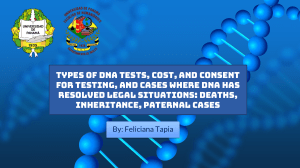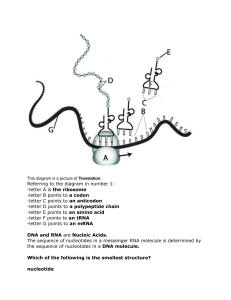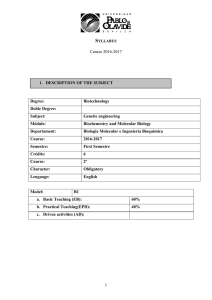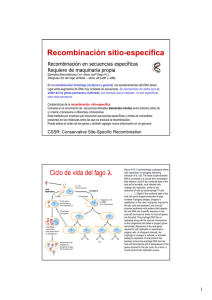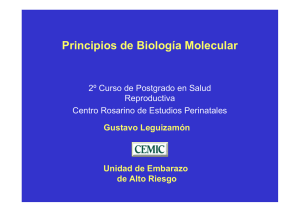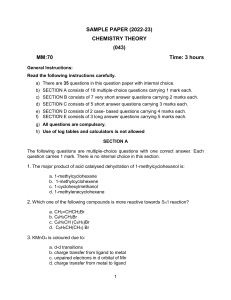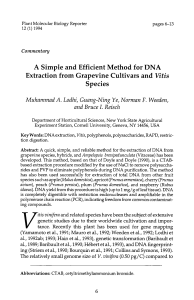291 Formaldehido como agente radioprotector Many substances
Anuncio
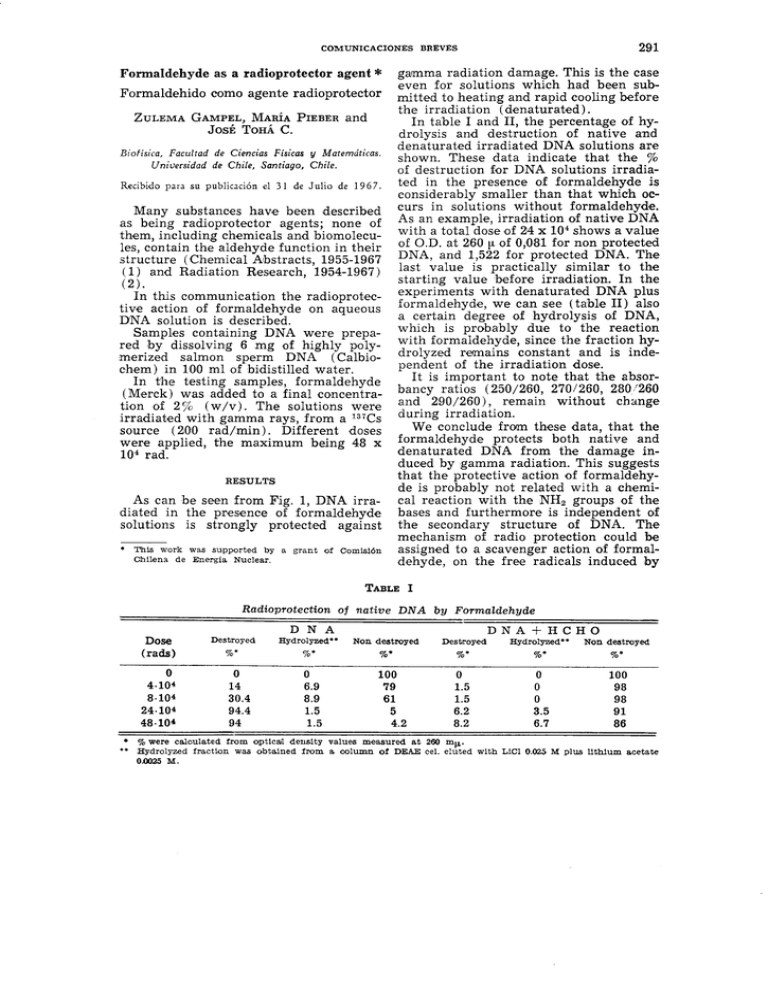
291 COMUNICACIONES BREVES gamma radiation damage. This is the case even for solutions which had been sub­ Formaldehido como agente radioprotector mitted to heating and rapid cooling before the irradiation (denaturated). ZULEMA GAMPEL, MARÍA PIEBER and In table I and II, the percentage of hy­ JOSÉ TOHÁ C . drolysis and destruction of native and denaturated irradiated DNA solutions are Biofísica, Facultad de Ciencias Físicas y Matemáticas. shown. These data indicate that the % Universidad de Chile, Santiago, Chile. of destruction for DNA solutions irradia­ ted in the presence of formaldehyde is Recibido para su publicación el 3 1 de Julio de 1 9 6 7 . considerably smaller than that which oc­ curs in solutions without formaldehyde. Many substances have been described As an example, irradiation of native DNA as being radioprotector agents; none of with a total dose of 24 x 10 shows a value them, including chemicals and biomolecu- of O.D. at 260 jx of 0,081 for non protected les, contain the aldehyde function in their DNA, and 1,522 for protected DNA. The structure (Chemical Abstracts, 1955-1967 last value is practically similar to the (1) and Radiation Research, 1954-1967) starting value before irradiation. In the (2). experiments with denaturated DNA plus In this communication the radioprotec­ formaldehyde, we can see (table II) also tive action of formaldehyde on aqueous a certain degree of hydrolysis of DNA, DNA solution is described. which is probably due to the reaction Samples containing DNA were prepa­ with formaldehyde, since the fraction hyred by dissolving 6 mg of highly poly­ drolyzed remains constant and is inde­ merized salmon sperm DNA (Calbio- pendent of the irradiation dose. chem) in 100 ml of bidistilled water. It is important to note that the absorIn the testing samples, formaldehyde bancy ratios (250/260, 270/260, 280/260 (Merck) was added to a final concentra­ tion of 2% ( w / v ) . The solutions were and 290/260), remain without change irradiated with gamma rays, from a Cs during irradiation. We conclude from these data, that the source (200 rad/min). Different doses were applied, the maximum being 48 x formaldehyde protects both native and denaturated DNA from the damage in­ 10 rad. duced by gamma radiation. This suggests that the protective action of formaldehy­ RESULTS de is probably not related with a chemi­ As can be seen from Fig. 1, DNA irra­ cal reaction with the NH groups of the diated in the presence of formaldehyde bases and furthermore is independent of solutions is strongly protected against the secondary structure of DNA. The mechanism of radio protection could be assigned to a scavenger action of formal­ • This work was supported by a grant of Comisión Chilena de Energía Nuclear. dehyde, on the free radicals induced by Formaldehyde as a radioprotector agent * 4 137 4 2 TABLE I Radioprotection Dose (rads) 0 4 10 810 Destroyed 4 4 2410 4 48 10* of native D N A Hydrolyzed** DNA by Non destroyed Formaldehyde Destroyed D N A + H C H O Hydrolyzed** Non destroyed %* %* %* %* %* %* 0 14 0 6.9 100 79 0 1.5 0 0 30.4 8.9 61 1.5 0 98 94.4 1.5 5 6.2 3.5 91 94 1.5 4.2 8.2 6.7 86 100 98 • % were calculated from optical density values measured at 260 m^. ** Hydrolyzed fraction was obtained from a column of DEAE cel. eluted with LiCl 0.025 M plus lithium acetate 0.0025 M. 292 COMUNICACIONES BREVES TABLE Radioprotection II of denaturated DNA by Formaldehyde D N A Dose (rads) Destroyed 0 410* 8 lO* 24-10* 4810* D N A + H C H O Hydrolyzied** Non destroyed %* %' %* 0 19.5 42.2 88.4 94.7 0 4.1 3.96 0 0.9 Destroyed %* 100 76.5 53.8 11.3 4.7 0 0 0 5.8 9 Bydrolyzed" Non destroyed %* %* 28 27,5 25.5 32.7 25.3 72 72.4 74.4 61.6 64.7 and * • See Table I. radiolysis of water. In this way formal­ dehyde could act as a trapper of oxygen, OH or peroxide radical, directly or in­ directly through the formation of a radi­ cal of the type HC(0)OCH, able to re­ lease H, (Marx R. and Chatay). This idea could be supported by the finding that the pH decreases during irradiation from 6,7 to 4,4 in the denatured DNA solution, and from 4,1 to 3,1 in solutions of denatu­ rated DNA plus formaldehyde indicating that there is a greater increase in H con­ centration in the latter conditions, due probably to trapping or recombination of OH. Work is in progress in our laboratory to evaluate the importance of the aldehy­ de function as a radioprotector, its mech­ anisms and the possibility that other non toxic aldehydes, such as carbohydrates, could present the same properties. ACKNOWLEDGMENTS We are grateful to Dr. I. Saavedra for his advice. The support of Comisión Chilena de Energía Nuclear is acknowledged. RESUMEN Se describe la acción radioprotectora de la molécula de formaldehido para so­ luciones acuosas de DNA, irradiadas con rayos gamma de una fuente de Cls. Se sugiere que la radioprotección sería de tipo indirecto, ya que este efecto se evidencia tanto en el DNA nativo como en el denaturado. Por otra parte, el hecho que paralelamente a la radioprotección se produzca un mayor descenso del pH en las soluciones irradiadas en presencia de formaldehido, podría interpretarse como debido a una menor recombinación de H, con los OH, atrapados en este caso por el formaldehido activado. Las razones de absorbancia 250/260, 270/260, 280/260 y 290/260, permanecen constantes durante la irradiación del DNA en presencia de formaldehido, lo que indicaría que la molécula de DNA mantendría su estructura. 1 3 7 REFERENCES 1 . — C H E M I C A L A B S T R A C T S . — Vol. 49 (1955) to Vol. 66, N<? 9, (1967). Absorbaney of irradiated DNA solution, at 260 m^. Black triangles, native DNA. White triangles, renatured DNA. Black circles, native DNA plus formalhehyde 2%. White circles, denatured DNA plus formaldehyde 2%. 2.—RADIATION RESEARCH. Vol. 1 (1954) to Vol. 30, N<? 1, (1967). 3.—MARX, R . and C H A T A Y , Phys. 58, 527 (1961). CI. — J. Chim.

